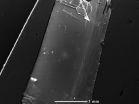(Press-News.org) This news release is available in German.
Graphene, the only one atom thick carbon network, achieved overnight fame with the 2010 Nobel Prize. But now comes competition: Such layers can also be formed by black phosphorous. Chemists at the Technische Universität München (TUM) have now developed a semiconducting material in which individual phosphorus atoms are replaced by arsenic. In a collaborative international effort, American colleagues have built the first field-effect transistors from the new material.
For many decades silicon has formed the basis of modern electronics. To date silicon technology could provide ever tinier transistors for smaller and smaller devices. But the size of silicon transistors is reaching its physical limit. Also, consumers would like to have flexible devices, devices that can be incorporated into clothing and the likes. However, silicon is hard and brittle. All this has triggered a race for new materials that might one day replace silicon.
Black arsenic phosphorus might be such a material. Like graphene, which consists of a single layer of carbon atoms, it forms extremely thin layers. The array of possible applications ranges from transistors and sensors to mechanically flexible semiconductor devices. Unlike graphene, whose electronic properties are similar to those of metals, black arsenic phosphorus behaves like a semiconductor.
Phosphorene vs. graphene
A cooperation between the Technical University of Munich and the University of Regensburg on the German side and the University of Southern California (USC) and Yale University in the United States has now, for the first time, produced a field effect transistor made of black arsenic phosphorus. The compounds were synthesized by Marianne Koepf at the laboratory of the research group for Synthesis and Characterization of Innovative Materials at the TUM. The field effect transistors were built and characterized by a group headed by Professor Zhou and Dr. Liu at the Department of Electrical Engineering at USC.
The new technology developed at TUM allows the synthesis of black arsenic phosphorus without high pressure. This requires less energy and is cheaper. The gap between valence and conduction bands can be precisely controlled by adjusting the arsenic concentration. "This allows us to produce materials with previously unattainable electronic and optical properties in an energy window that was hitherto inaccessible," says Professor Tom Nilges, head of the research group for Synthesis and Characterization of Innovative Materials.
Detectors for infrared
With an arsenic concentration of 83 percent the material exhibits an extremely small band gap of only 0.15 electron volts, making it predestined for sensors which can detect long wavelength infrared radiation. LiDAR (Light Detection and Ranging) sensors operate in this wavelength range, for example. They are used, among other things, as distance sensors in automobiles. Another application is the measurement of dust particles and trace gases in environmental monitoring.
A further interesting aspect of these new, two-dimensional semiconductors is their anisotropic electronic and optical behavior. The material exhibits different characteristics along the x- and y-axes in the same plane. To produce graphene like films the material can be peeled off in ultra thin layers. The thinnest films obtained so far are only two atomic layers thick.
INFORMATION:
This work was supported by the Office of Naval Research (ONR), the Air Force Office of Scientific Research (AFOSR), the Center of Excellence for Nanotechnologies (CEGN) of King Abdul-Aziz City for Science and Technology (KACST), the German Research Council (DFG) and the TUM Graduate School.
Publication:
Black Arsenic-Phosphorus: Layered Anisotropic Infrared Semiconductors with Highly Tunable Compositions and Properties
Bilu Liu, Marianne Köpf, Ahmad N. Abbas, Xiaomu Wang, Qiushi Guo, Yichen Jia, Fengnian Xia, Richard Weihrich, Frederik Bachhuber, Florian Pielnhofer, Han Wang, Rohan
Dhall, Stephen B. Cronin, Mingyuan Ge, Xin Fang, Tom Nilges, Chongwu Zhou
Adv. Mater., 2015, Early View - DOI: 10.1002/adma.201501758
Chicago - Although opioids are frequently prescribed to treat chronic lower back pain, new research suggests these powerful medications may be less effective in some patients. A study published in the Online First edition of Anesthesiology, the official medical journal of the American Society of Anesthesiologists® (ASA®), found patients who were prescribed opioids to treat chronic lower back pain experienced significantly less pain relief and were more likely to abuse their medication when they had psychiatric disorders such as depression or anxiety.
"High levels ...
Neuroscientists at Duke University have introduced a new paradigm for brain-machine interfaces that investigates the physiological properties and adaptability of brain circuits, and how the brains of two or more animals can work together to complete simple tasks.
These brain networks, or Brainets, are described in two articles to be published in the July 9, 2015, issue of Scientific Reports. In separate experiments reported in the journal, the brains of monkeys and the brains of rats are linked, allowing the animals to exchange sensory and motor information in real time ...
The human eye is an amazing instrument and can accurately distinguish between the tiniest, most subtle differences in color. Where human vision excels in one area, it seems to fall short in others, such as perceiving minuscule details because of the natural limitations of human optics.
In a paper published today in The Optical Society's new, high-impact journal Optica, a research team from the University of Stuttgart, Germany and the University of Eastern Finland, Joensuu, Finland, has harnessed the human eye's color-sensing strengths to give the eye the ability to ...
UBC research shows world's monitored seabird populations have dropped 70 per cent since the 1950s, a stark indication that marine ecosystems are not doing well.
Michelle Paleczny, a UBC master's student and researcher with the Sea Around Us project, and co-authors compiled information on more than 500 seabird populations from around the world, representing 19 per cent of the global seabird population. They found overall populations had declined by 69.6 per cent, equivalent to a loss of about 230 million birds in 60 years.
"Seabirds are particularly good indicators of ...
Chemotherapy treatment usually involves the patient receiving medicine through an intravenous catheter. These catheters, as well as the the equipment attached to them, are treated with a silver coating which is antibacterial, preventing bacterial growth and unwanted infections during a treatment.
Researchers at the Norwegian University of Science and Technology's (NTNU) Department of Physics are now studying what happens when different drugs come in contact with this silver coating.
Silver breaks down chemotherapy drugs
"We wanted to find potential problem sources ...
This news release is available in German.
Although global concentration of greenhouse gases in the atmosphere has continuously increased over the past decade, the mean global surface temperature has not followed the same path. A team of international reseachers, KIT scientists among them, have now found an explanation for this slowing down in global warming: the incoming solar radiation in the years 2008-2011 was twice as much reflected by volcanic aerosol particles in the lowest part of the stratosphere than previously thought. The team presents their study ...
In a recent article in Nature, Keith Shepherd and the Land Health Decisions team at the World Agroforestry Centre (ICRAF), together with their external partners, propose a radically new method to the SDG community that would answer these questions. They call on the United Nations and private sector to dispense with the highly criticized target setting approach and adopt the new method of decision analysis.
The target setting approach is widely seen as ineffective or counter-productive. Targeting emphasizes meeting a 'target' rather than learning how to improve performance ...
The quality of waters can be assessed using of the organisms occurring therein. This approach often results in errors, because many species look alike. Therefore, new methods focus on DNA analyses instead. Biologists at the Ruhr-Universität Bochum (RUB) have optimised the process so that they are now able to identify many organisms at once in a quick and reliable manner using short DNA sequences. The results have been published in the PLOS ONE magazine.
Expert knowledge for species identification threatens to disappear
Industry, agriculture and human settlement ...
Researchers at the University of Liverpool's Institute of Infection and Global Health (IGH) have discovered a common cause of heart damage in patients with sepsis.
Sepsis is the most common cause of death in hospitalised critically ill people and affects up to 18 million people world-wide annually.
The electrical and mechanical malfunctions of the heart have been poorly understood in sepsis, with underdeveloped clinical management strategies, as a consequence. This new discovery, however, promises to benefit a high number of patients with heart failure or rhythm ...
Since 1994, researchers at Case Western Reserve University have studied mothers--some who used cocaine while pregnant and others who did not--to understand how the drug affected their children's cognitive and social development.
Their latest findings suggest a link between prenatal cocaine exposure and an adolescent's likelihood to have sexual intercourse before age 15.
Teens who were prenatally cocaine exposed (PCE) were 2.2 times more likely to engage in sexual intercourse before age 15 than those who weren't, yet how PCE affects early sexual behavior may differ ...






